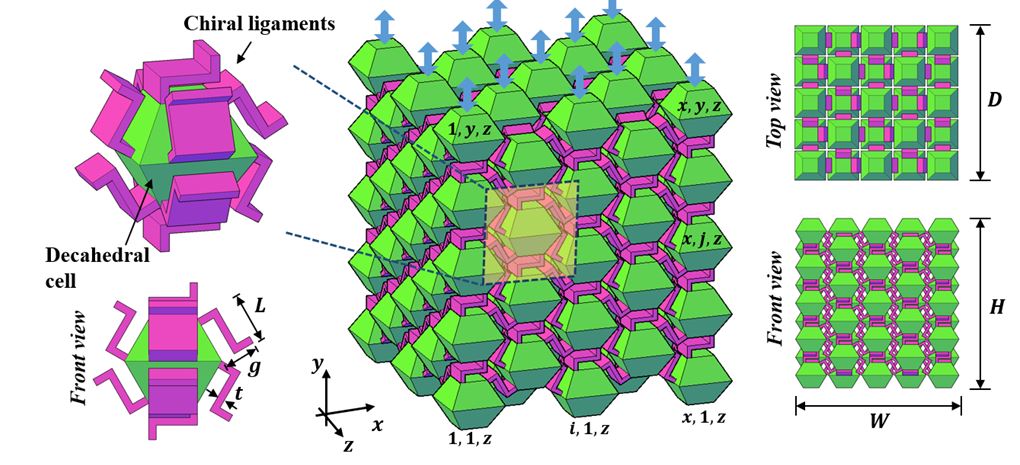Video Article Open Access
Chiral Metastructures with Tunable Poisson’s Ratio Subjected to Tension and Compression
Pengcheng Jiao
Institute of Port, Costal and Offshore Engineering, Ocean College, Zhejiang University, Zhoushan 316021, Zhejiang, China
Vid. Proc. Adv. Mater., Volume 2, Article ID 2108207 (2021)
DOI: 10.5185/vpoam.2021.08207
Publication Date (Web): 21 Aug 2021
Copyright © IAAM
Graphical Abstract

Abstract
Architected metastructures assembled by periodic design patterns, e.g., mechanical metamaterials, have been extensively studied in recent years, mainly due to their prominent mechanical response such as ultra-light with ultra-stiffness, which leads to multifunctional applications in different areas, including micro-electro-mechanical systems (MEMS), energy harvesting, actuation, etc. Taking the advantages of local-patterning, architected metastructures are locally characterized with respect to the periodic patterns in the perspective of structure; on the other hand, the overall response of metastructures is typically considered in the perspective of material. Therefore, advanced structures are reported with promising performance beyond the property limitations of structure materials. Here, we report a novel type of metastructures with tunable tensile and compressive Poisson’s ratios resulted in periodically chiral patterns. In particular, the tunability of Poisson’s ratio (i.e., from positive to negative) is investigated in terms of the chirality of the proposed 3D structures. A discretization algorithm is reported to convert the architected structures into deformation matrixes, and an analytical model is developed accordingly to obtain the discretized governing equation. Finite element models are built in ABAQUS using the explicit dynamic solver with geometric nonlinearity. 3D printing technique is applied to fabricate the metastructures, and experiments are carried out using the MTS loading machine to investigate the Poisson’s ratio under tension and compression. The testing results are compared with the theoretical and numerical predictions, and satisfactory agreements are obtained. To reveal the relationship between the chirality and effective material properties, parametric studies are conducted to indicate the influences of the microstructures’ periodic patterns on their Poisson’s ratio. Density plots of the chiral structures are provided with respect to the pattern ratio and chirality ratio and therefore, the optimal geometries are obtained for the metastructures with the best controllability. The chiral metastructures presented in this study open exciting venues for control and manipulation of architected structures, which leads to multifunctional applications in many fields
Keywords
Advanced metastructures; chiral local-patterning; tunable poison’s ratio; tension and compression.
Acknowledgement
This study is supported by the Startup Foundation of the Hundred Talents Program at the Zhejiang University.
Biography
Pengcheng Jiao earned his MSc and PhD degrees in Civil Engineering from West Virginia University and Michigan State University in 2012 and 2017, respectively. Prior to joining the Ocean College at Zhejiang University as Research Professor in 2018, Dr. Jiao was working as Postdoctoral Research Fellow in the Department of Mechanical Engineering and Applied Mechanics at University of Pennsylvania.
Dr. Jiao’s research interests include advanced metastructures, mechanical metamaterials, multiscale structural stability analysis, artificial intelligence in costal engineering, structural health monitoring and energy harvesting. Particular interests are focused on: 1) conceptual development and investigation of structural components and systems to expand advanced features; 2) micro/nanoscale fabrication and testing of plate-shaped mechanical metamaterials; 3) applications of artificial intelligence algorithms in design and optimization of marine structures; and 4) deployment of metastructures for multifunctional applications such as vibration-enabled energy harvesting and damage sensing in structural health monitoring.
In the past five years, Dr. Jiao has authored/coauthored more than 60 peer-reviewed journal publications and has delivered several invited or keynote presentations. In addition, he has worked as PI/co-PI in NSFC, NSF-Zhejiang and other projects issued in China and participated in several NSF and US DOT projects. Currently, Dr. Jiao’s research group has 2 PhD, 6 MS and 4 undergraduate students.
Video Proceedings of Advanced Materials

Upcoming Congress



